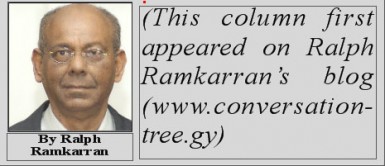It was President George H W Bush’s February 1990 Republic Day message to President Desmond Hoyte, expressing the hope that the upcoming elections will be free and fair, that signalled the end of the West’s four decade hostility to the PPP, starting in 1953. Dr Jagan had written to the US President in December 1989 seeking US support for free and fair elections in Guyana.
 Earlier in 1989 Dr Jagan wrote to President Gorbachev, President of the USSR, also seeking his support. Dr Jagan had reminded President Gorbachev of the latter’s earlier support of President Bush’s demand for free and fair elections in Nicaragua, which was a friend of the USSR. Dr Jagan’s hope was that President Gorbachev would elicit a quid pro quo from President Bush for his support on Nicaragua by supporting free and fair elections in Guyana. Dr Jagan figured that with the Cold War fading, it was the opportune time for convincing the US to review its hostility to the PPP by supporting democracy in Guyana.
Earlier in 1989 Dr Jagan wrote to President Gorbachev, President of the USSR, also seeking his support. Dr Jagan had reminded President Gorbachev of the latter’s earlier support of President Bush’s demand for free and fair elections in Nicaragua, which was a friend of the USSR. Dr Jagan’s hope was that President Gorbachev would elicit a quid pro quo from President Bush for his support on Nicaragua by supporting free and fair elections in Guyana. Dr Jagan figured that with the Cold War fading, it was the opportune time for convincing the US to review its hostility to the PPP by supporting democracy in Guyana.
The new Jagan government in 1992 accepted the PNC’s Economic Recovery Programme and embraced the IMF’s stringent conditionalities. Together these offered debt relief without which Guyana could not have survived. It also opened the doors to World Bank, IDB and bilateral resources. President Jagan’s visit to the US was highly successful and the decades-long rift between the PPP and the US was effectively healed.
When President Jagdeo assumed office in 1999, the West was thrilled that the youthful represetative of the next generation of PPP leaders had made every effort to separate himself from the PPP’s ideological past. How is it then that the PPP, which was removed from office twice in its history, and kept out of office for near three decades, all by the West, managed to once again offend and alienate Western countries?
Notwithstanding the IMF-led strategy, which emphasized bilateral and multilateral aid and poverty reduction, macro-economic stability and market prescriptions, the economy refused to grow because of Guyana’s chronic political instability. The structure of Guyana’s economy in 1953, based on the export of rice, sugar and bauxite has changed only marginally by the addition of logs and gold as exports, while the export of bauxite had so declined that it was no longer consequential. Loans, grants and remittances supplemented an unchanging, commodity-based, export profile. When Guyana became a lower middle income country after years of modest growth, cheap loans and grants were no longer available and thus new inflows had to be found to sustain social services, the development budget and, as the PPP perceived, its continued electoral dominance. President Jagdeo’s Low Carbon Development Strategy and his Middle East visits were designed to overcome this problem.
As part of his Middle East outreach in January 2010, President Jagdeo’s delegation visited Iran and was promised assistance in identifying mining deposits, speculated to be uranium. The US had already deemed Iran a ‘state sponsor of terrorism’ and had become deeply concerned with its growing nuclear programme. Sanctions had been first imposed by the US in 1979 and later escalated, then imposed by the UN. Since Iran’s isolation was a major objective of US foreign policy, the US would have been very unhappy about the Guyana visit, especially since President Jagdeo expressed disagreement with US policy towards Iran.
Aside from Iran, Guyana’s relations with Cuba, a benefactor to Guyana, and with Venezuela, with which Guyana has a border controversy, would not have presented any difficulties in its relations with the US. The government and PPP, though considered to be on the ‘left,’ had been hitherto careful not to join any ‘anti-imperialist’ crusade. But the agreement with Iran would have caused the US to take notice.
In August 2012 Guyana abstained on a vote at the UN on Syria. The resolution, which was widely supported, condemned the use of heavy weapons in civilian areas and the widespread violations of human rights, demanded that all parties commit to ending the conflict and called for the resignation of President Assad. Guyana’s also abstained on a vote at the UN in April 2014 on a resolution which declared invalid the Russian-supported Crimean referendum on its secession from Ukraine. Guyana deeply offended the West by its vote on these resolutions, which the US considered to be important to its national interests. By this time Guyana no doubt appeared to be adopting a knee-jerk, anti-Western diplomatic posture.
Compounded with the above, internal differences aggravated relations with the West. The refusal to hold local government elections, the prorogation of the National Assembly, the PPP’s attitude to foreign representatives, corruption, arrogance and the PPP’s adamant refusal to countenance political stability by inviting at least one opposition party into the government, even in anticipation of the 2015 elections, incurred serious Western concerns.
Against this background, the government clashed with Western diplomats in Georgetown over the local government elections and the prorogation issues. The ‘feral blast’ at the US’s July 4th celebration, which doubled up as a farewell party for the Ambassador, and a ‘good riddance’ to the UK High Commissioner after his end of tour press conference, would have done nothing to sustain, in 2015, Western hopes for the PPP’s success in the early 1990s and the early 2000s.







